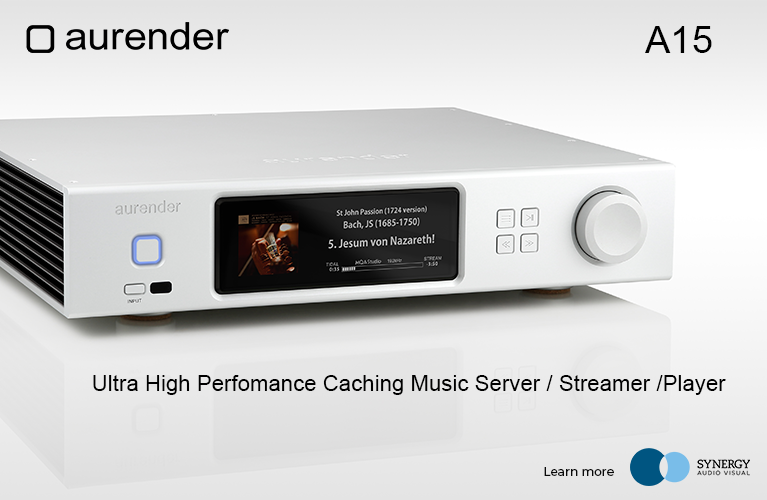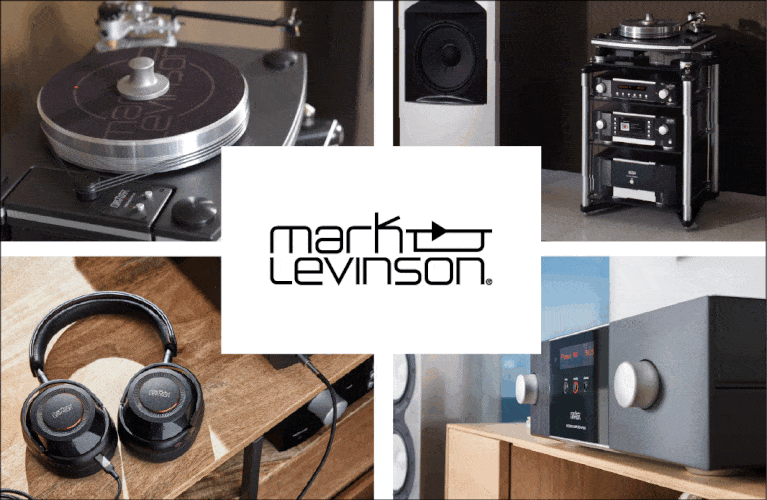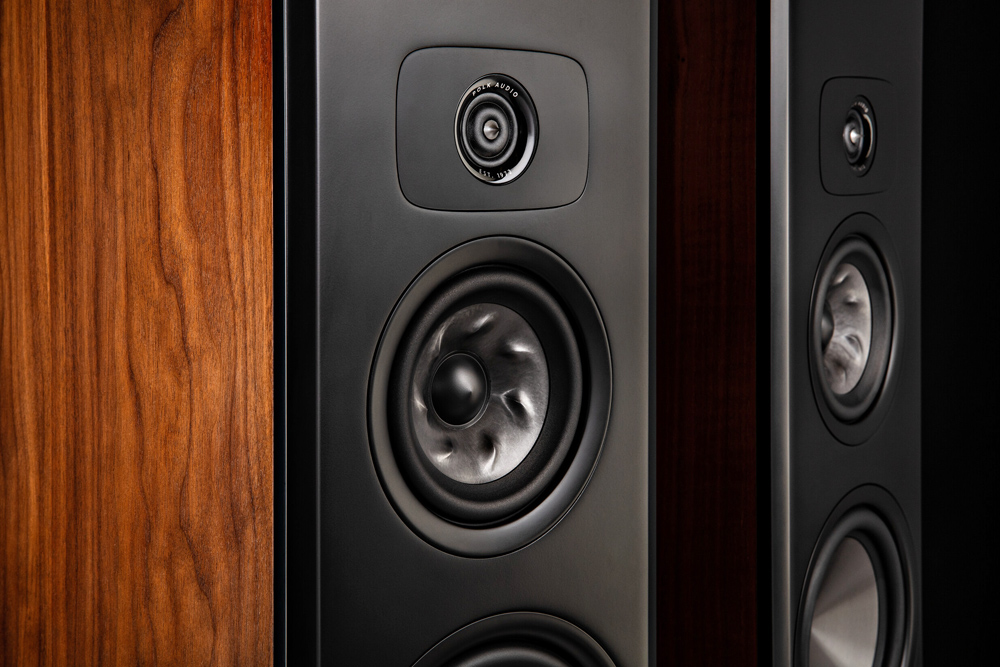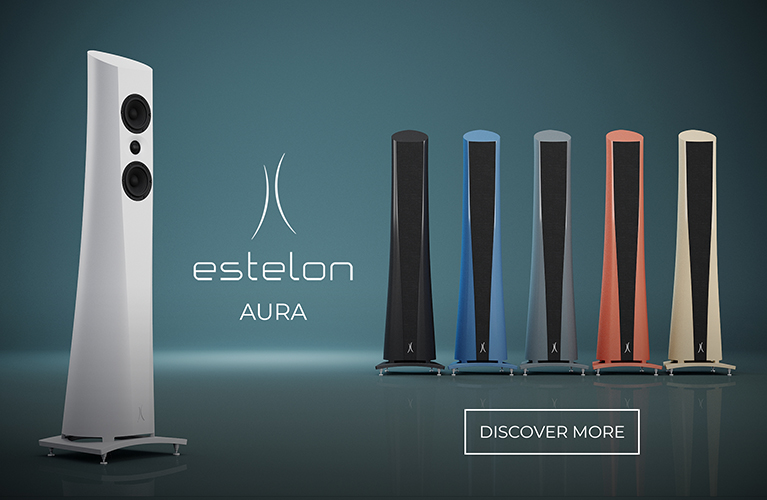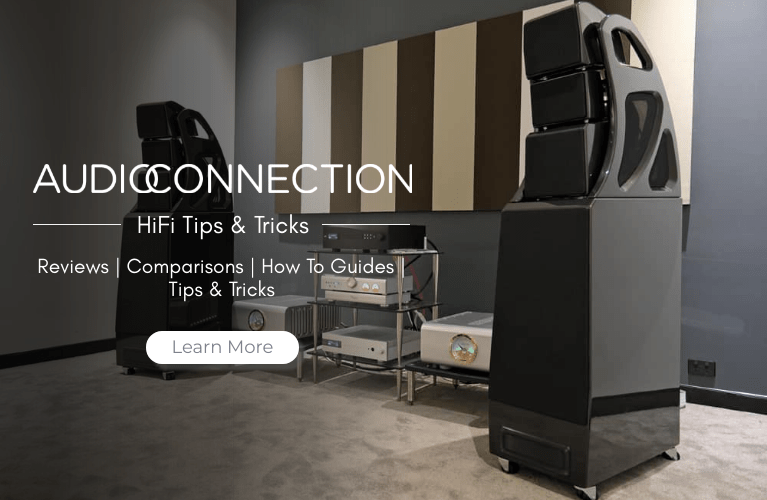Back in 1972, Mathew Polk and a team of big dreamers with just $200 between them set out on a wildly determined voyage to bring engaging, immersive sound to the masses of music lovers. With no interest in producing esoteric “cost-no-object products”, Polk’s real challenge was to deliver a truly great audiophile experience at a cost most people could afford. This established its founding philosophy of sound and design. Do the newest generation ‘Legend Series’ L600 speakers reaffirm the over 50-year-old mandate?
Celebrating 50 years
Beginning in a large, decrepit, 20+ room house rented in the rough side of Baltimore in the USA, Polk Audio was formed. It quickly became obvious there was a need to help spread the cost of rent. This presented an opportunity for friends and travelling musicians for a place to live – if they didn’t mind living in a small factory that was growing exponentially throughout most of the property. While some of these lodgers became involved in the business, everyone contributed in some way, but mostly through collaborations on what a speaker should sound like.
Conceptualising on a niche within a growing modern consumer electronics industry, the Monitor 7 became Polk’s first successful speaker among Hi-Fi retailers who quickly realised they combined the best of what European speakers had to offer with purity of midrange, the ability to reproduce voice, while having enough bass to provide an element of fun. Fifty years on, it’s a stable that still holds true with all Polk Audio speakers being produced today.
The Legend series are Polk Audio’s latest top-of-the-line speaker range, encapsulating nearly five decades of everything Polk Audio has accomplished with inspirations derived from the Monitor series and the SDA-SRS model, through to the epitome of the company’s other successes that have claimed numerous awards.
Utilising the next generation of the patented SDA technology and an enhanced version of the Power Port, Polk defines the Legend Series as the best speakers the company has ever created, with the promise of delivering the best sound in their class. The series consists of the L800 and L600 tower speakers, the L200 and L100 bookshelf speakers, the L400 centre speaker and the L900 height modules. The L600 Tower speakers is the model in review.
Innovations & Founding Philosophies
The L600s, sitting under the L800s, are the slimmer model of the two floorstanding speakers. A three-way tower measuring at just 32.92cm wide, 118.59cm high and 40.39 deep and weighing 35.29 kg, honours a sleek looking speaker that captures your eyes as they slowly wander over the beautifully constructed cabinet. It features rounded edges (both attractive and technically sound) and feels solid and is obviously well braced. The sides and back of the towers are covered in real wood veneer, with my review pair having a fine Black Ash finish (Walnut finish is also available) that allows the timber grain to be appreciated. The front baffle, the top of the speaker and the open bass port at the bottom is finished in a black gloss paint. It’s a modern look that I quite like and sits well among my furniture in the room. The anti-diffraction speaker grilles snap magnetically to the front but as a single full-length piece, they feel a little flimsy when removing them. A two-piece grille would have been better, I think. There is also a top grille to cover the face plate or the L900 height module, if installed as an optional extra.
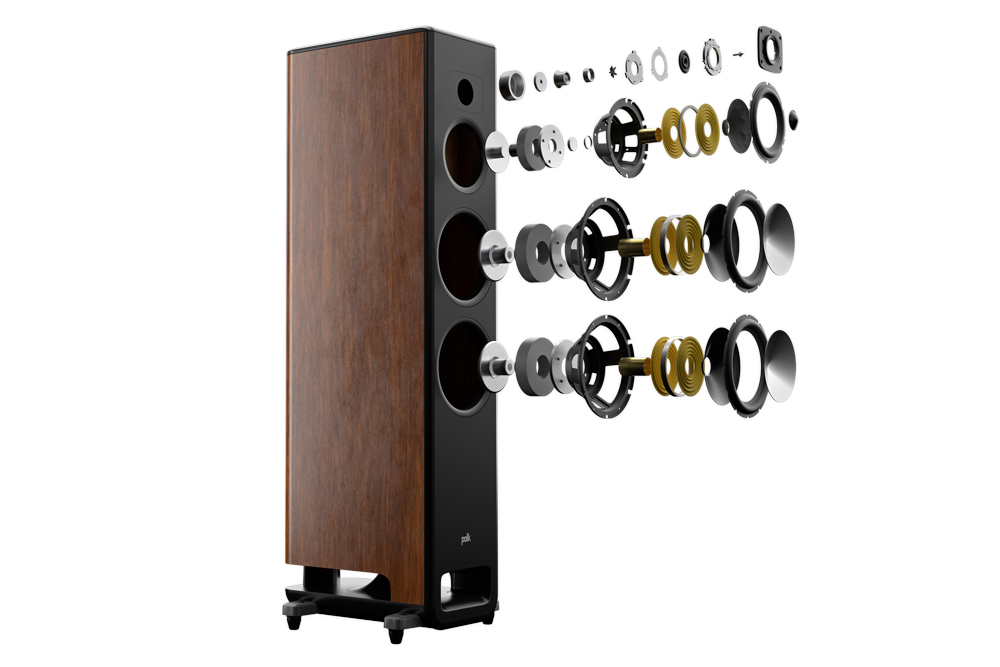
Each tower consists of a 1 inch ‘Pinnacle’ ring radiator tweeter, now in its third generation. Also on-board are the new 5.25 inch ‘Turbine’ midrange cone, developed specifically for the Legend series and dual high-excursion 7 inch, long throw woofers working mutually with the new ‘Enhanced Power Port’, which flows from open cut-outs at the base of the towers. Around the back you will find two sets of 5-way binding posts, allowing bi-wiring or bi-amping. A little above these are a single set of speaker connectors already installed and wired internally for the installation of the L900 height modules. All the connectors are large and of good quality, are widely spaced and feel secure when tightening. To keep the towers sturdy, there are two straight edged outriggers consisting of dual-floor compatible feet. A nifty idea from Polk that allows the feet to sit on carpets but also has a rubber boot for hard floors. These offer improved stability and bass coupling to the floor and are adjustable to provide that perfect level.
Polk recommends power handling at 100 watts per channel and although the 125 watts of power from my Marantz AVR performed quite well, a sensitivity of 86dB (1 watt/1 metre) makes the L600s challenging to drive to their peak. A point confirmed when I switched over to my 400-watt monoblocks. The extra muscle had the speakers singing at their best with better focus and control, particularly in the bass region, but more on that later. Frequency response is said to be 28 Hz to 50 kHz, offering full range potential. Nominal impedance range is 3.3 to 4 ohms with a 3-way ‘Orth’ crossover which has the midrange/woofer crossover frequency at 410 Hz and tweeter/midrange frequency at 2900 Hz. Power handling is quoted between 30 to 300 watts peak per channel and as I stated earlier, the more power you can feed the L600s, the better they will perform.
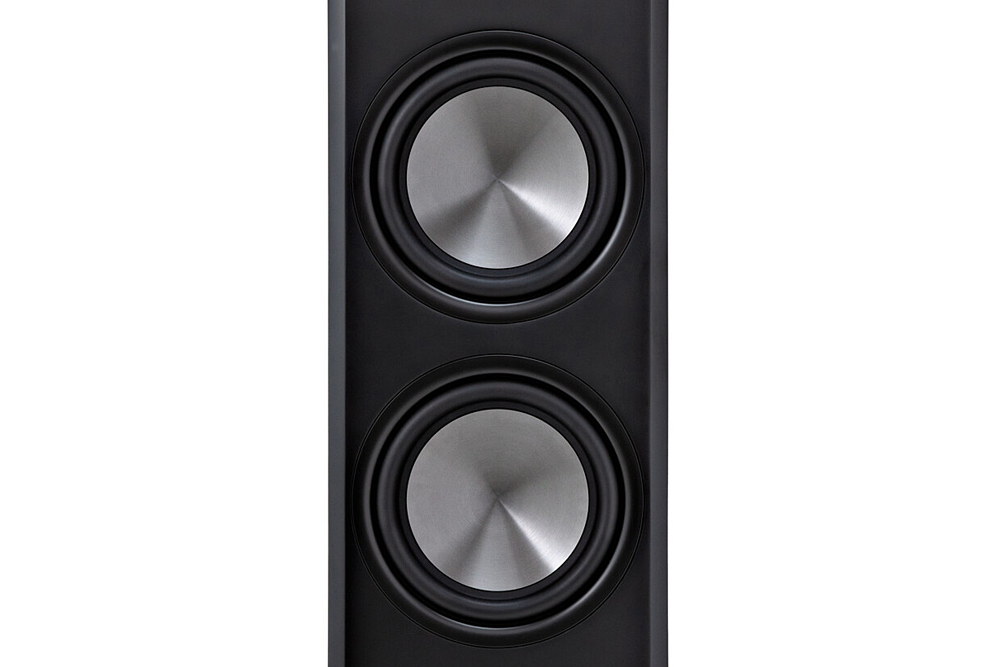
Polk’s third generation Pinnacle Ring Radiator tweeter has a very distinctive looking pointed waveguide that is quite eye catching and these little spires are engineered to optimise sound dispersion. This creates a bigger, more uniform listening sweet-spot that offers greater off-axis participation with more listeners. Also optimised is the cavity behind the tweeter to reduce resonances and ringing, resulting in accurate transient sounds. Polk claims its new tweeter reproduces crisp, clear highs with no colouration or distortion.
The familiar looking Turbine Cone midrange driver finds the perfect balance of cone lightness and stiffness through both materials and design. Starting with an injection-moulded cone that sandwiches air inside a rigid foam structure, resulting in a thicker, firmer cone without adding extra weight. Fin-like edges are then added in a vortex pattern to compound the cones stiffness without increasing its mass. As a result, resonances are pushed out of the driver’s range and it’s claimed Polk’s newly created cone will never bend or flex, preventing break-up. No matter how loud you crank it, they will retain natural, balanced mid-range frequencies with dazzling dimensionality. Behind the cone, dual spiders working in a push-pull manner support the suspension to move the overhung voice coil in and out more effectively while allowing it to travel further – permitting it to handle more power and move more air. The ‘Flux Modulation’ control rings and an ultra-efficient motor, further reduce distortion and increase accuracy.
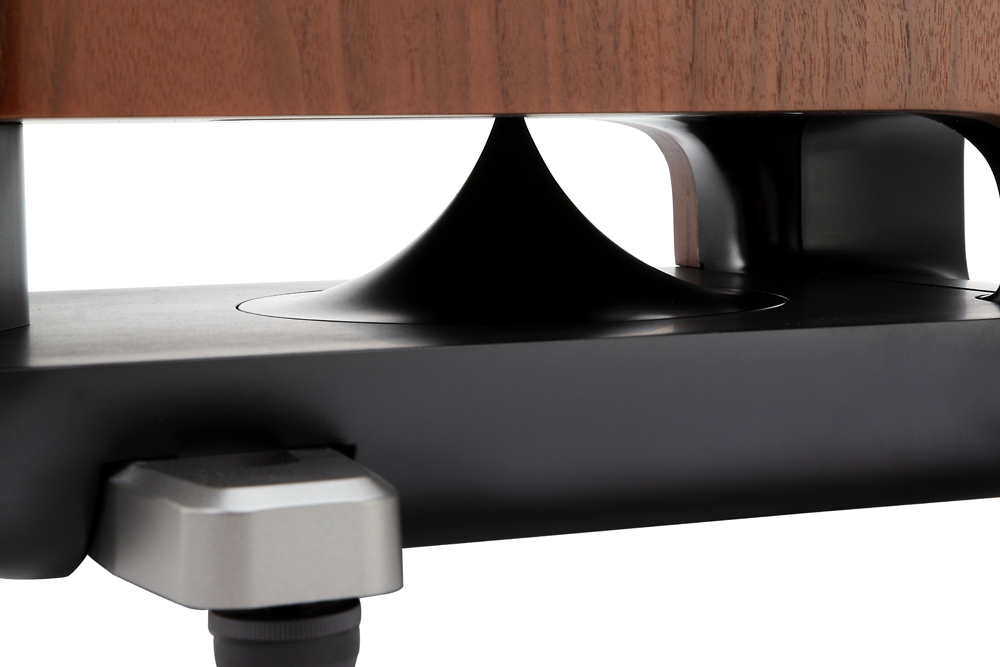
Bass, done better, is the catch phrase behind the enhanced Power Port technology of Polk’s Legend series. Advancing on the original power port design of controlling airflow to eliminate turbulence, envisioned the use of flares at the end of the port and a diffuser – that pointy bit you see at the bottom. Polk have refined the flares to promote a more streamlined, or laminar flow, which generates less port noise and more bass over its predecessor. As a result, smoother airflow is guided into the listening space through the cut-outs at the base of the cabinets for cleaner, tighter bass.
Designed for Music and Movies
Polk Audio have designed the L600s for stereo listening and home theatre enjoyment in a single pair of towers. One feature supporting this is the ingenious idea of the Atmos certified L900 height speakers which seamlessly integrate directly inside the top of the towers. Replacing the difficulty of installing speakers into a ceiling, or adding toppers to your speakers, you simply remove the screwed-in top plate and flush-mount the L900s inside the sealed enclosure with internal wiring ready to connect. The height modules horizontal orientation ensures both the phase and time alignment for the 0.75 inch Ring Radiator horn loaded tweeter and the 4 inch Turbine cone delivering a large sweet-spot via ceiling reflections to the listening position. The L900 modules are an optional extra and are not included in this review.
The question that kept arising throughout my time evaluating the L600s is, do they perform better for music playback or movie soundtracks? To answer that question, I had to delve into a different audio frontier to SoundStage! Australia’s stereo focus – home cinema sound.
Now to be clear, this review primarily concentrates on the stereo performance of the L600s so I’ll refrain from being discursive on their home theatre presentation, but since Polk are claiming its Atmos ready towers are perfect for stereo listening or home theatre, I feel a potential buyer would be interested to know how they sound in both roles.
Once I had connected the speakers to my Marantz 7015 AVR, I proceeded to do something I had not done in quite a while – thanks to the convenience of streaming services available these days. I fired up the old trusted Oppo 105D and inserted the “Mad Max Fury Road” Blu-ray disc, presented by Warner Bros Pictures and directed by George Miller.
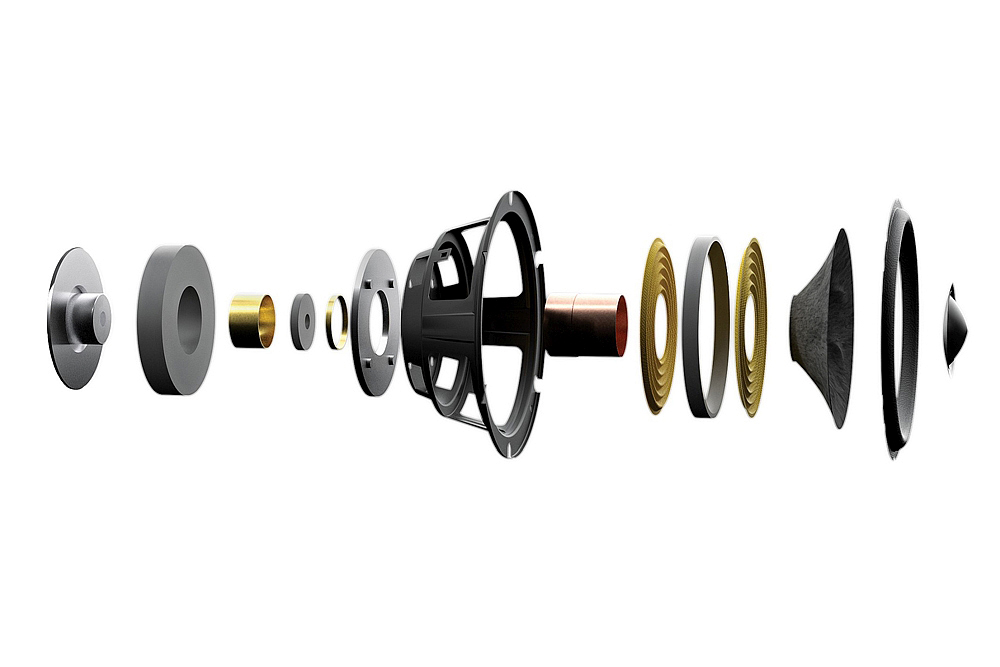
Using just the L600 towers as main left and right fronts (with no centre channel) and my rear surrounds with the sub turned off, the opening scene had me totally engaged from the moment I pushed play. With the volume at almost reference level, the L600s showed no signs of strain or distortion while supplying a high energy and vivid sound.
The monologue from Mad Max is crisp and well centred, while the atmosphere of the scenery expanded way beyond the speakers and the walls – and this was before the surrounds kicked in with haunting voices screaming out around you. I was not expecting the amount of thud the L600’s enhanced Power Port emitted as Max’s foot comes crashing down on the approaching little critter. Seriously, I had to check that my sub was indeed turned off. Engines accelerate with raw grunt as turbulent fumes spatter from their exhaust, while explosions release billowing deep bass that has the matching presence of two small subs and is quite satisfying. Although the L600s do not have the identical amount of depth and energy my 12-inch sub delivers in the room, they are more than capable without it.
Even without surround speakers, you are encircled with sound due to the massive soundstage. With surrounds, you are completely immersed in the movie. Sounds strike with speed and precision and do so with bite, heightening those tense moments. All your senses and emotions are coupled to the movie’s soundtrack and Polk’s L600 towers do this in a way my main speakers alone, could not. The scalability is immense, as is the full range imaging that’s quite expansive and is appropriate to the letterboxed visuals.
The L600s impressed me with its ability to remain focussed and in control, even at high volumes and proved to be as entertaining to listen to, as your favourite movie is to watch. But how will they compare with music?
Stereo Listening
Since the L600s were already setup and tweaked for the perfect position with my AVR, all that was needed to do was to connect the speakers to my monoblock amps. My 2-channel rig is completely independent to my home theatre setup, running a dedicated power conditioner which has the amps, a preamp, a DAC and a source connected to it.
It’s been three decades since I last heard a pair of Polk Audio speakers, and I wasn’t sure what to expect before listening to the L600s. As audiophiles, we all have a degree of bias when it comes to products that don’t reach our expectations. It’s easy to get excited about Hi-Fi that aligns to our taste, but it’s even easier to dismiss something that doesn’t. It took me some time to adjust to the sound of the L600s and this was further delayed by the need to run the speakers in. But even after many weeks of use, I still found the midrange and tweeter to be lacking life and openness. I knew the drivers were capable of so much more, even for a speaker designed and priced for the masses. It then occurred to me to swap out the supplied jumper leads on the speakers’ binding posts with my Anti Cable level 5 signature jumpers.
Wow, wow, wow. What a transformation. The melancholy sound was replaced with an injection of hope. Gone was the fog that hovered over the mid and upper frequencies. The hefty bass became less influential, and balance was restored to the towers 3-way drivers. Anyone that doesn’t believe that cables can make a difference, needs to hear this. With the L600s now showing what they are truly capable of, I finely had a sound I could write about.
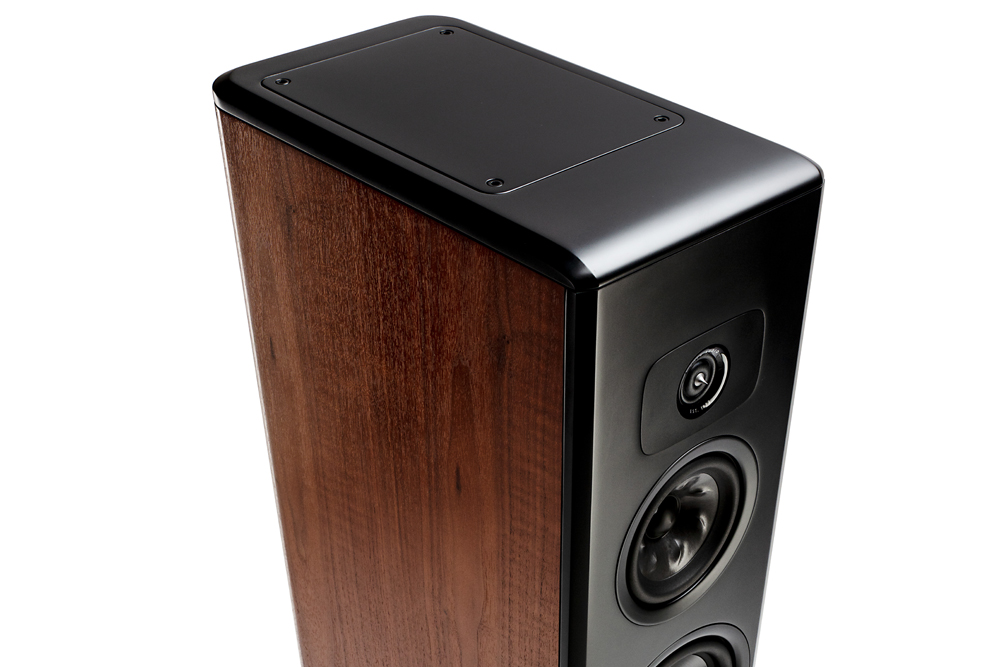
Anyone familiar with the slow burning track “Hey Now” by London Grammar from their debut album If You Wait, will know why I chose this song. The L600s somewhat weighted tone favours the frost and solitude of Hannah Reid’s slighted voice as it hovers dead centre between the speakers. The midrange and tweeter start to blossom with good clarity as her strength emerges through the lyrics, highlighting Hannah’s range and reveals the reverb around her vocals quite nicely. As spectral keyboard notes and timid guitar riffs enter the atmospheric soundstage, the instruments are well positioned, although the imaging seems slightly stretched. I found this effect worked well with movies, but with music it tends to be at the expense of pinpoint accuracy, blurring the edges between separation.
During the song’s driving drum beat and the various deep tones of the organ, I was pleasantly surprised by the bass control the L600s produced here – my jumper cables aiding with better low-end definition as well. The bass is quite deep and has the presence of a sub in play. Any muddiness I was expecting is minimal and what is present is likely being compounded by the lack of space and nearby furniture in my room, which is to be expected considering the measure of bass on offer. Between the kick drum and the organ notes, the L600s managed to almost partition the two with the drumbeat coming from the bass drivers and the deep organ flowing from the Power Port while still retaining its symbiotic relationship. The pinnacle tweeter’s high notes offer much needed contrast to the tracks deep tones without overstretching into the fatigue zone, yet still has enough edge to construct an overall balance to the song.
A great start to my listening session that revealed an impressive bass response from the L600s that I wanted more of but without limiting myself to just bass pumping tracks.
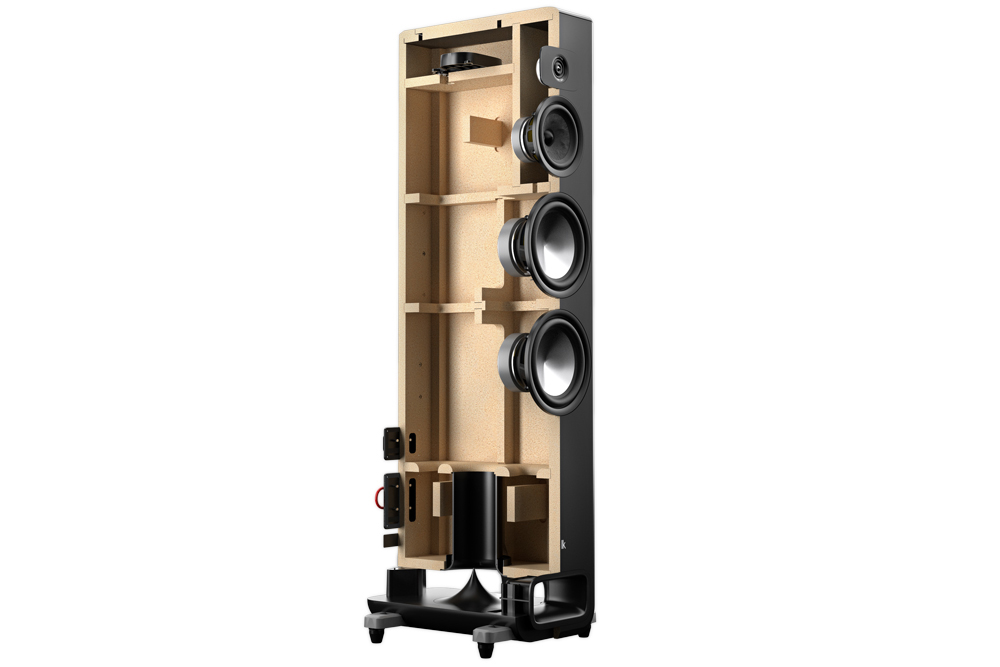
The Greencards’ track, “Ocean Floor” from the high-res (24-bit/44 kHz) album Sweetheart of the Sun is a beautifully poetic song that evokes a mood of ambience and stillness. The languid flowing tune’s acoustic guitar has a sweet and touching tone that shines through with the plucking of the strings’ high notes, revealing the natural harmonics amidst the sense of endless space the L600s do so well. Subtle moments like these are rendered effortlessly in scale and shows the speakers are capable of a softer side. Carol Young’s gorgeous voice is not the cleanest of recordings with an added reverb effect causing her vocals to sound slightly veiled, but this is compensated somewhat by the speakers’ dispersive soundstage and larger vocal presence.
Sporadically throughout the track, there is that drop-out bass note I adore so much in music like this. I was anticipating something special and the L600s power port didn’t disappoint. There is greater punch and presence of this note than I’ve ever heard from this track before. I’m surprised by the depth and weight of the bass flowing into my room as it inserts a solid foundation to the bottom landscape of the song without any vertical rise interfering with the midrange. Normally I would find the extension here to be short lived, but I feel it’s overstayed a tad on the Polks.
As big and gratifying as the bass can be on the L600s, the caveat is that some bass notes can overhang, but certainly not always, and it really comes down to the track’s recorded bass frequencies. A point noted when playing “Little Giant”, the title track from Roo Panes’ debut album. The softly struck kick drum is firm but is shown restraint by the L600s power port with only the bass drivers in play. Anything more would weigh the airy presentation of this song down. The tone on Roo’s voice is ideal, while his upper range is pushed to the edge without becoming sharp or bright. I find his vocal has a larger presence than usual but once the choir-like backing vocals rise towards the ceiling, it’s all put into perspective within the larger soundstage.
Switching to the jazz group The Yuri Honing Trio, showed a more transparent side to the L600s while playing their version of Sting’s “Walking on the Moon” from the Star Tracks album. This style of music allows the upper frequencies of the speakers to step out of the shadow of its bass brethren. The great sonic qualities of the recording are yielded by the L600s ability to create space and dynamics with ease. The walking bassline of the double bass sets a solid, yet firmer foundation as Yuri Honing’s saxophone is portrayed in all its glory. The control shown by the speakers during this track restores balance and focus to the sound which reveals more textures and decay to the instruments’ natural reverb. There’s better transients, speed and attack on Joost Lijbaart’s drums as cymbals shimmer and fade.
It’s a shame I don’t have a larger room for the L600s bass to spread out and dissipate into. I would love to hear if a more focused sound is possible across other genres, as it showed with jazz tracks.
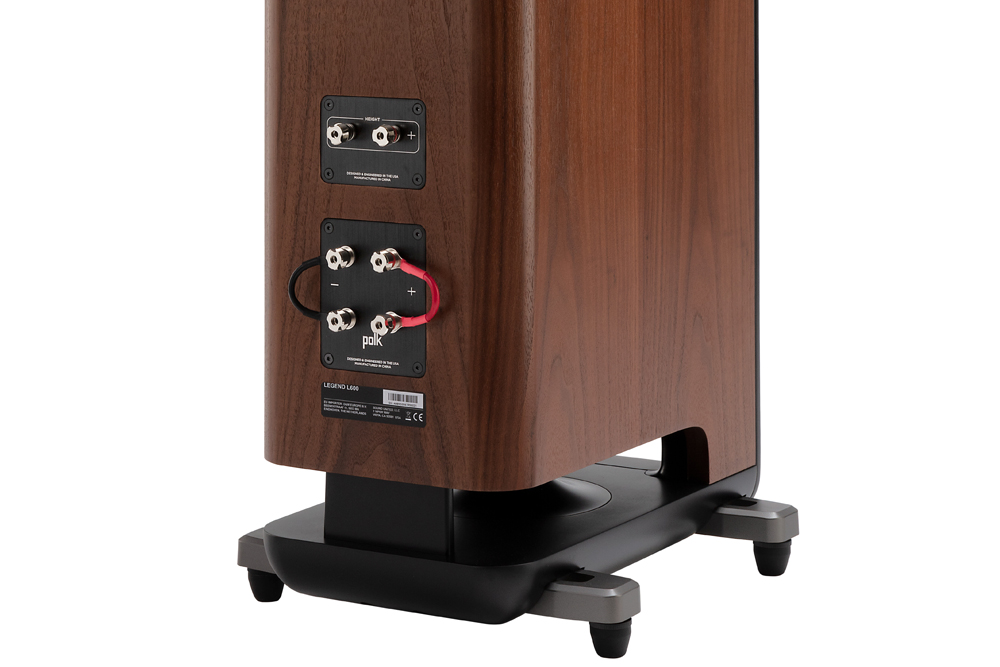
I must confess to the audiophile crime of using tone controls when I was younger. Yes, I know but surely, I wasn’t the only one who lacked knowledge and maturity to begin with? Was I? The L600s have rekindled those earlier years of my Hi-Fi journey. Back to when more bass was desired at the expense of colouration and enjoying my music was the only significant factor. There was freedom from thinking about transparency, resolution and mid-bass bloom, while having volume levels on the threshold of clipping. Over time, I unravelled the complexities of understanding good sound and soon realised tone controls artificially increase the bass tones and intensity to the point you have totally lost the balance and naturalness of the source as it was recorded. It is much better to seek a speaker like the L600s that can produce deep bass naturally, rather than pushing a driver beyond its range and capabilities – creating distortion, or worse, blowing a driver.
Conclusion
The LS600s have been a fascinating speaker for me to evaluate, and yet tricky to write about. To gauge the stereo and home theatre performances into a single review has raised some disparities in my assessments, but the contradictions only exist if you compare one against the other. As with most systems, there can be compromises to the overall sound and the LS600s are no different when tackling each duty but do a stellar job as a single pair of speakers without a sub.
Circling back to the question “Do the L600s perform better for movies or music”? Well, that depends on your expectations and preferences. For me, I would have to lean towards movies. There’s really nothing to fault with how well the L600s present and perform for a movie’s dialogue, soundtrack and action scenes. But that’s not to say the musical capabilities of the L600s are objectively inferior… far from it. While Polk Audio has accomplished everything it set to achieve with the Legend Series, I personally found I was wanting more refinement in some areas of the sound with a tighter balance between the upper and lower frequency range. I was not getting a forensic insight into my favourite tracks and nor was I expecting to. Having said that, it’s important to note that I’m being super picky here with comparison to my reference speakers which have the sole purpose of music reproduction. The L600s allow you to enjoy your music in a fun way without the distraction of analysing the sound or the system, while providing enough detail for most music lovers who appreciate a large, full-bodied sound with strong bass.
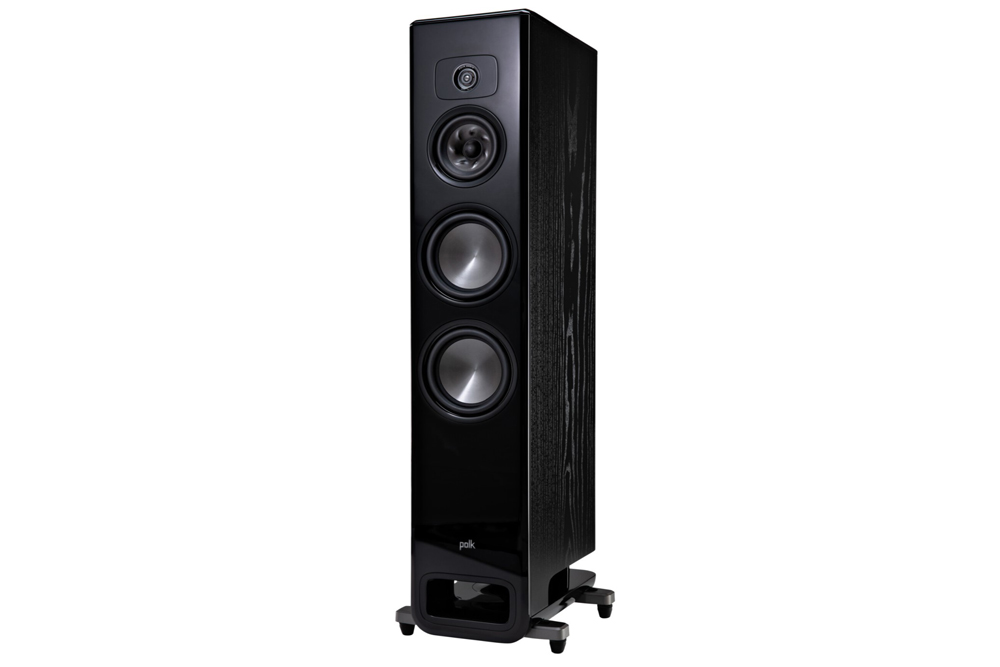
I believe, with a little effort and consideration, optimum sound is attainable with the L600s. Here’s what I would suggest: Allow them space to breathe – let all that bass flow into the room unrestricted without compounding it. Play around with toe-in – you don’t want that expansive soundstage to have a hole in the middle. Buying a power amplifier with more quality watts will see a return on that investment – greater control will create better definition, focus and a sharper image. Finally, upgrade the jumper cables, or better still, buy the best speakers cables you can afford in a bi-wire configuration – It would be criminal not to. Incremental enhancements will see these speakers exceed the best sound in their class.
Although I wasn’t sure to begin with, Polk Audio have won me over with its ability to design and build great sounding speakers with prodigious bass in a tall, slim tower that are also adaptable to home theatre, making them ideal for those with limited space but still seeking great all-round sound at a bang for buck price. Searching for a speaker that accommodates all that? Then the Polk Audio Legend Series L600 speakers is to be seriously considered.
… Steven JM Polley
www.soundstageaustralia.com
Associated Equipment
- Speakers – Hulgich Audio Ella MkII, B&W 801 S2 Matrix w/North Creek X-overs, KEF LS50, LSX II
- Amplifier – Nord One SE NC500 monoblocks with Sonic Imagery buffer
- Preamplifier – Denafrips Athena
- AVR – Marantz SR7015
- Sources – Antipodes DX2, running Roon, Oppo 105
- DAC – Chord QBD76
- Cables – Synergistic Research Apex speaker cable, Vertere Pulse-B XLR cables, Analysis Plus Digital Crystal XLR AES/EBU cable, Power Oval 2 and Power Oval 10 power cords, IsoTek EVO3 Optimum power cord, Anti-Cable level 5 signature jumper cables
- Room Treatment – Vicoustic Flexi Wood Ultra and Flexi A50 panels
- Power Conditioner - IsoTek EVO3 Sigmas powerline cleaner
- Miscellaneous – IsoAcoustics Gaia II feet, Basalt speaker blocks
Polk Audio Legend L600 Loudspeakers
Price: AU$6999
Australian Warranty: Five Years
Australian Distributor: Masimo Consumer
+61 2 9196 8990
www.polkaudio.com
Polk Audio America
5541 Fermi Court
Carlsbad CA 92008
United States of America
+1 1 (800) 377-7655
www.polkaudio.com



